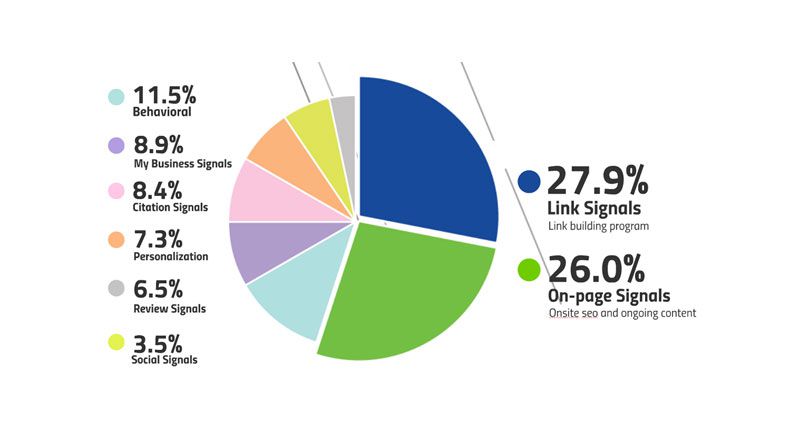Stumped on how to get your keyword to rank in Google? Good news! You are not alone. This is an everyday occurrence for anyone in the small business world. And entrepreneurs should care about their keyboard rankings. In fact, 93% of all online experiences begin in a search engine. With the correct SEO strategies, you will be able to leverage these queries to your advantage. Keyword Ranking Factors relies on relevance, quality content, user experience, backlinks, site speed, optimization, and social signals for search success.
Keyword ranking factors are elements that influence a webpage’s position in search engine results for specific keywords. These factors include content relevance, quality, backlinks, user experience, site speed, mobile optimization, and social signals, impacting a page’s visibility and ranking on search engine results pages (SERPs).
Where to start? I think it’s appropriate to start discussing what I and many digital experts believe are the top three ranking factors. Every year, Moz conducts a survey of the top digital marketers, asking them what the ranking factors are. We will use these results to guide our article today.
Become a Backlinking Ninja
According to Moz, the number one ranking factor is link signals. This has been at the top of the list the last several years. It is the one thing that all digital experts can agree on. Backlinks still matter and will into the future. Now that we know the top ranking factor, what can we do to begin building authoritative backlinks to help out your keyword rankings? Here are a few insightful tips for what makes up a great backlink and how we can acquire them.

- Anchor Text: This is the hyperlink pointing back to your website. Imagine anchor text like your 401k portfolio. You need to diversify. About one-third of your anchor text ought to be branded, another third should be the keywords you want to rank on (dentist in Los Angeles), and the final third should be generic.
- Link Domain Authority: This is a score from a third-party data provider that assesses how authoritative your domain is. Domain authority encompasses a lot of what goes into keyword ranking factors. It understands the number of backlinks pointing to your site, the quality of the content on your website, review signals, social signals, etc.
- Link Domain Quantity: The number of domains pointing to your domain. The easiest way to describe this is thinking about each domain having a vote. The more votes you receive the more relevant your website will look in the eyes of search engines.
- Link Domain Relevance: Lastly, how relevant are these backlinks to your website? If you are the dentist, you want other dentist domains pointing backlinks to your website. If you’re the dentist and have a website like the Food Network pointing towards you, it’s great; however, it isn’t as relevant to your industry.
How do you begin building your backlink portfolio? A good first step is to reach out to a local marketing agency. They should have the tools to help build relevant authoritative backlinks.
On-Page Signals
The second ingredient to achieving successful rankings is on-page signals. On-page signals and backlink building really go hand-in-hand. It’s kind of like pairing cheese with a good wine. On-page signals, though, are much easier to control and improve. The reason being that you have control of your website and you’re not asking others to link back to you. Let’s take a look at what makes up these on-page signals.
- NAP: This stands for name, address, phone number. Obviously, this is your business name and your business location and the phone number to reach you at. Search engines like to see this on your website and to ensure it is consistent with what is in directories. You hear the phrase ‘consistent NAP’ quite often. This simply means, does the same name, address, and phone number show up on their website and on directories?
- Keyword in Title: The keyword the page is looking to rank for should appear on the page. Does it appear in the title tag, H1, and marketing copy? This seems like a very simple and obvious factor, and it is. So go take a look at the keyword you want to rank on and make sure it shows up somewhere on the page.
- Domain Authority: We reviewed this in the backlink building section. The better your domain authority, the greater the odds that you’ll have higher rankings.
Behavioral Signals
The third and final ranking factor we are going to cover today is behavioral signals. Again, backlink signals and on-page signals are going to affect your behavioral signals. What makes up behavioral signals? A few of them are click-through-rate, dwell time, and mobile click to call. Let’s review them in more detail.
- Click-Through Rate: What is click-through rate? When somebody lands on your website, do they go to another page on your website? Assuming that you have quality and engaging content on your website, then the odds increase that people will begin exploring the rest of your website.
- Dwell Time: This is how long somebody is staying on your website. Again, do you have engaging and high-quality content on your website? Videos help, especially ones that are do-it-yourself videos. Typically, with these types of videos, there’s a lot of starting and stopping.
- Mobile Click to Call: This is a very simple signal to add if you don’t already have it. Find somebody who knows a bit about web development and ask them to add this feature to your mobile site. Frequently there are plugins that you can use to add this feature.
Conclusion
As you are probably already assuming, SEO takes time and patience. Depending on your budget and resources, really determine how quickly you might start seeing results. Remember to have patience when dealing with search engine optimization. Tackling these three raking factors will be a great start to digital success. Start tracking total keyword rankings, domain authority, and organic visitors to your website. Each month, if you continue to work on these three ranking factors, you should see steady improvement month-over-month. And lastly, don’t be discouraged when a Google algorithm update is released that affects your website in the short-term. SEO is similar to your 401k; there are bound to be ups and downs.

Namaste UI collaborates closely with clients to develop tailored guest posting strategies that align with their unique goals and target audiences. Their commitment to delivering high-quality, niche-specific content ensures that each guest post not only meets but exceeds the expectations of both clients and the hosting platforms. Connect with us on social media for the latest updates on guest posting trends, outreach strategies, and digital marketing tips. For any types of guest posting services, contact us on info[at]namasteui.com.

